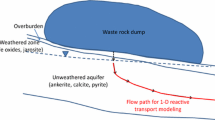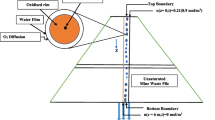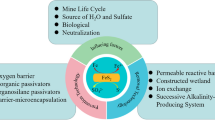Abstract
Acid mine drainage (AMD) is pollution that occurs when water trapped in abandoned coal mines leaks out into the local environment. One of the most abundant metals found in AMD is iron. Iron precipitates out of the system naturally in the form of iron(III) hydroxide, leading to a decrease in fluid pH. Iron oxidizing bacteria can promote this reaction process, assisting in the removal of Fe(II) ions from the AMD. This paper develops a model of an AMD system that includes thin film sheet flow and reactive transport of ions. In addition the model analyzes the precipitation of an iron(III) hydroxide crust as a function of space and time. Several parameters are varied to compare model predictions with field observations. Forcing low concentrations of oxygen in the system slows the rate of iron(III) hydroxide crust growth. Increasing the angle of inclination of the sheet flow while holding the flow rate fixed causes a very small decrease in iron(III) hydroxide crust growth due to faster flow through a thinner fluid film. Decreasing the flow rate of the system while maintaining a fixed angle of inclination to simulate a thinning of the liquid layer produces a slower iron(III) hydroxide crust growth rate. When the angle of inclination is increased with fixed fluid film thickness, iron(III) hydroxide crust growth decreases due to downstream transport of the ions. Oxidation and precipitation reaction rates had the greatest influence on crust growth. An increase in iron oxidizing bacteria can increase the oxidation of Fe(II). Therefore, an increase in the abundance of iron oxidizing bacteria can increase the rate of iron(III) hydroxide crust growth.










Similar content being viewed by others
References
Ardejani, F.D., Shokri, B.J., Bagheri, M., Soleimani, E.: Investigation of pyrite oxidation and acid mine drainage characterization associated with Razi active coal mine and coal washing waste dumps in the Azad shahr-Ramain region, northeast Iran. Environ. Earth Sci. 61, 1547–1560 (2010)
Baker, B.J., Banfield, J.F.: Microbial commuities in acid mine drainage. FEMS Microbiol. Ecol. 44, 139–152 (2003)
Burgos, W.D., Royer, R.A., Fang, Y.: Theoretical experimental considerations related to reaction-based modeling: a case study using Iron(III) oxide bioreduction. Geomicrobiol. J. 19, 253–287 (2002)
Burke, S.P., Banwart, S.A.: A geological model for removal of Iron(II)(aq) from mine water discharges. Appl. Geochem. 17, 431–443 (2002)
DeSa, T.C., Brown, J.F., Burgos, W.D.: Laboratory and field-scale evaluation of low-ph Fe(ii) oxidation at Hughes Borehole, Portage Pennsylvania. Mine Water Environ. 29, 239–247 (2010)
Gouin, M.: Acid mine drainage remediation utilizing iron-oxidization bacteria. Master’s thesis, The University of Akron (2011)
Herlihy, A.T., Kaufmann, P.R., Mitch, M.E.: Regional estimates of acid mine drainage impact on streams in the mid-Atlantic and southeastern United States. Water Air Soil Pollut. 50, 91–107 (1990)
Johnson, D.B., Hallberg, K.B.: Acid mine drainage remediation options: a review. Sci. Total Environ. 338, 3–14 (2005)
Kirby, C.S., Cravotta III, C.A.: Net alkalinity and net acidity 1: theoretical considerations. Appl. Geochem. 20, 1920–1940 (2005)
Kirby, C.S., Thomas, H.M., Southam, G., Donald, R.: Relative contributions of abiotic and biological factors in Fe(II) oxidation in mine drainage. Appl. Geochem. 14, 511–530 (1999)
Oron, A., Davis, S., Bankoff, S.: Long-scale evolution of thin liquid films. Rev. Mod. Phys. 69(3), 931–980 (1997)
Senko, J.M., Bertel, D., Quick, T.J., Burgos, W.D.: The influence of phototrophic biomass on Fe and S redox cycling in an acid mine drainage-impacted system. Mine Water Environ. 30, 38–46 (2011)
Senko, J.M., Wanjugi, P., Lucas, M., Bruns, M.A., Burgos, W.D.: Characterization of Fe(II) oxidizing bacterial activities and communities at two acidic Appalachian coalmine drainage-impacted sites. ISME J. 2, 1134–1145 (2008)
Author information
Authors and Affiliations
Corresponding author
Rights and permissions
About this article
Cite this article
Gouin, M., Saracusa, E., Clemons, C.B. et al. A mathematical model of a passive scheme for acid mine drainage remediation. Int J Geomath 4, 27–53 (2013). https://doi.org/10.1007/s13137-012-0044-3
Received:
Accepted:
Published:
Issue Date:
DOI: https://doi.org/10.1007/s13137-012-0044-3




